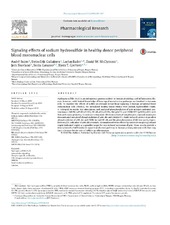Signaling effects of sodium hydrosulfide in healthy donor peripheral blood mononuclear cells
Sulen, Andre; Gullaksen, Stein-Erik; Bader, Lucius; McClymont, David; Skavland, Jørn; Gavasso, Sonia; Gjertsen, Bjørn Tore
Peer reviewed, Journal article
Published version

Åpne
Permanent lenke
https://hdl.handle.net/1956/15243Utgivelsesdato
2016-11Metadata
Vis full innførselSamlinger
Originalversjon
https://doi.org/10.1016/j.phrs.2016.08.018Sammendrag
Hydrogen sulfide (H2S) is an endogenous gasotransmitter in human physiology and inflammatory disease, however, with limited knowledge of how signal transduction pathways are involved in immune cells. To examine the effects of sulfide on relevant intracellular signaling in human peripheral blood mononuclear cells (PBMCs), we stimulated healthy donor PBMCs with sodium hydrosulfide (NaHS, 1–1000 μM) to mimic H2S stimulation, and analyzed phosphorylation of p38 mitogen activated protein kinase (MAPK) (pT180/pY182), NF-κB p65 (pS529), Akt (pS473) and CREB/ATF1 (pS133/pS63) with flow and mass cytometry. In contrast to transient effects in subsets of lymphocytes, classical monocytes demonstrated sustained phosphorylation of p38, Akt and CREB/ATF1. NaHS induced calcium dependent phosphorylation of p38, Akt and CREB, but not NF-κB, and the phosphorylation of Akt was partly dependent on p38, indicative of p38-Akt crosstalk. Attenuation of these effects by molecules targeting p38 and Hsp90 indicated Hsp90 as a possible target for H2S-induced activation of p38. These results provide a description of a NaHS-induced signal transduction pathway in human primary immune cells that may have relevance for the role of sulfides in inflammation.
